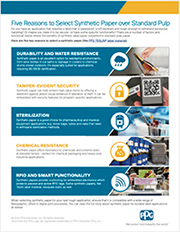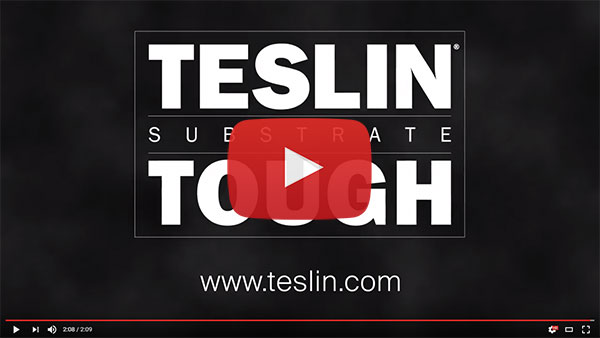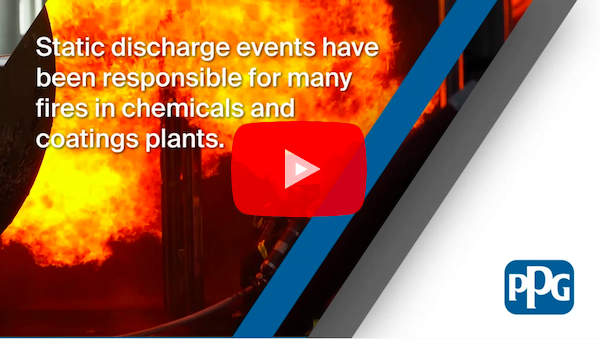Do you have an application that requires a label that is waterproof, scuff-resistant and tough enough to withstand excessive handling? Or maybe you need it to be secure---or have some specific functionality? There are a number of factors and functional needs where the total range of benefits of synthetic label paper outperforms standard pulp paper.
Here are the top five reasons to select a synthetic paper label (like our durable, secure and easy-to-print PPG TESLIN® label material).

1.Durability and Resistance Against Water and Moisture
If your application needs to resist water and other types of moisture (condensation, steam), a synthetic paper is the right solution. Synthetic paper is an excellent option for labels that need to withstand damp environments...from wine bottles in ice baths to signage in coolers and freezers to chemical drums located in outdoor storage areas. In fact, if your application requires BS 5609 certification, synthetic paper is even more important. BS 5609-certified labels are proven to meet the most stringent tests for durability and are suitable for use in harsh environmental conditions. To obtain BS 5609 certification, printed labels need to withstand a three-month salt water submersion test in the English Channel.
If your application needs to resist water and other types of moisture (condensation, steam), a synthetic paper is the right solution. Synthetic paper is an excellent option for labels that need to withstand damp environments...from wine bottles in ice baths to signage in coolers and freezers to chemical drums located in outdoor storage areas. In fact, if your application requires BS 5609 certification, synthetic paper is even more important. BS 5609-certified labels are proven to meet the most stringent tests for durability and are suitable for use in harsh environmental conditions. To obtain BS 5609 certification, printed labels need to withstand a three-month salt water submersion test in the English Channel.

2. Tamper-Evident and Tamper-Resistant Security
Counterfeit products—that is, any goods or packaging that bear a trademark that is virtually the same as one registered to an authorized trademark owner—are one of the most significant global threats to brands and those who hold intellectual property rights to them. They also pose significant risks to public health and safety, the economy, and even national security. 1
For some brand owners, one of the most important considerations for choosing synthetic label stock is the level of security performance it offers. Consider synthetic paper if you need to improve the security of a high value item that requires a visual deterrent against and/or evidence of alteration or theft. In addition to exceptional bond strength, many synthetic papers are tear-resistant, others offer void technology options. A synthetic paper like Teslin substrate can be embedded with program-specific security features that are great for track and trace applications. And many synthetics don’t require added printing, converting and cost to ensure tamper evidence.
Counterfeit products—that is, any goods or packaging that bear a trademark that is virtually the same as one registered to an authorized trademark owner—are one of the most significant global threats to brands and those who hold intellectual property rights to them. They also pose significant risks to public health and safety, the economy, and even national security. 1
For some brand owners, one of the most important considerations for choosing synthetic label stock is the level of security performance it offers. Consider synthetic paper if you need to improve the security of a high value item that requires a visual deterrent against and/or evidence of alteration or theft. In addition to exceptional bond strength, many synthetic papers are tear-resistant, others offer void technology options. A synthetic paper like Teslin substrate can be embedded with program-specific security features that are great for track and trace applications. And many synthetics don’t require added printing, converting and cost to ensure tamper evidence.

Five Reasons to Select Synthetic Paper over Standard Pulp
The next time you have an application which requires durability, security, sterilization, chemical resistance or RFID tagging, evaluate the many advantages of synthetic paper.

3. Sterilization
Synthetic paper is also a good choice for Pharmaceutical and Medical Equipment applications needing tamper-evident protection for prescription or over-the-counter labels. Blood bags and tubes or vials requiring tight mandrel performance are also excellent candidates for synthetic paper. Check with your substrate provider to ensure that their synthetic paper can also pass gamma, ethylene oxide (EtO) and beta ray sterilization, as well as steam sterilization at 125°F for 20 minutes and cryofreeze applications reaching -160°F.
Synthetic paper is also a good choice for Pharmaceutical and Medical Equipment applications needing tamper-evident protection for prescription or over-the-counter labels. Blood bags and tubes or vials requiring tight mandrel performance are also excellent candidates for synthetic paper. Check with your substrate provider to ensure that their synthetic paper can also pass gamma, ethylene oxide (EtO) and beta ray sterilization, as well as steam sterilization at 125°F for 20 minutes and cryofreeze applications reaching -160°F.

4. Chemical Resistance
When selecting labels for chemical packaging and heavy-duty industrial applications, certain synthetic papers offer resistance to chemicals and solvents even at elevated temperatures. Synthetic paper is an excellent solution when you need to achieve GHS-compliance or simply to produce a durable label that stands up to harsh shipping and environmental conditions. A great synthetic paper option is Teslin substrate because it impedes static build-up (see our static test video comparing Teslin labels to vinyl) during digital printing to reduce clumping and stacking leading to increased productivity. Workplace safety is also enhanced as the material absorbs and dissipates static build-up in hazardous environments to reduce risks associated with electrical discharge and arc-flash related fires.
When selecting labels for chemical packaging and heavy-duty industrial applications, certain synthetic papers offer resistance to chemicals and solvents even at elevated temperatures. Synthetic paper is an excellent solution when you need to achieve GHS-compliance or simply to produce a durable label that stands up to harsh shipping and environmental conditions. A great synthetic paper option is Teslin substrate because it impedes static build-up (see our static test video comparing Teslin labels to vinyl) during digital printing to reduce clumping and stacking leading to increased productivity. Workplace safety is also enhanced as the material absorbs and dissipates static build-up in hazardous environments to reduce risks associated with electrical discharge and arc-flash related fires.

5. RFID and Other Functionality
As brand owners are adding special functionality and embedded electronics to their labels for capabilities like brand authentication, synthetic paper is becoming an ideal solution for RFID labels. One reason is because a synthetic paper like PPG TESLIN substrate provides cushioning and dissipates static which protects passive and active RFID tags thus extending the life cycle and read range of RFID labels.
When selecting synthetic paper for your next “tough” application, ensure that it is compatible with a wide range of flexographic or offset print processes as well as digital print technologies including laser, thermal transfer and inkjet for on-demand and variable data printing. Depending on the print technology you use, some synthetics require pretreatment coatings, special inks and drying equipment.
Do you have a durable label application that demands synthetic paper? If so, check out our Synthetic Paper Label Comparison Guide to see how Teslin substrate compares to other synthetic papers.
We offer both PPG Teslin label stock and face stock to meet your applications and process needs. To request a sample of Teslin label material, click here.
1 Center for Anti-Counterfeiting and Product Protection Professor, School of Criminal Justice Michigan State University
As brand owners are adding special functionality and embedded electronics to their labels for capabilities like brand authentication, synthetic paper is becoming an ideal solution for RFID labels. One reason is because a synthetic paper like PPG TESLIN substrate provides cushioning and dissipates static which protects passive and active RFID tags thus extending the life cycle and read range of RFID labels.
When selecting synthetic paper for your next “tough” application, ensure that it is compatible with a wide range of flexographic or offset print processes as well as digital print technologies including laser, thermal transfer and inkjet for on-demand and variable data printing. Depending on the print technology you use, some synthetics require pretreatment coatings, special inks and drying equipment.
Do you have a durable label application that demands synthetic paper? If so, check out our Synthetic Paper Label Comparison Guide to see how Teslin substrate compares to other synthetic papers.
We offer both PPG Teslin label stock and face stock to meet your applications and process needs. To request a sample of Teslin label material, click here.
1 Center for Anti-Counterfeiting and Product Protection Professor, School of Criminal Justice Michigan State University




